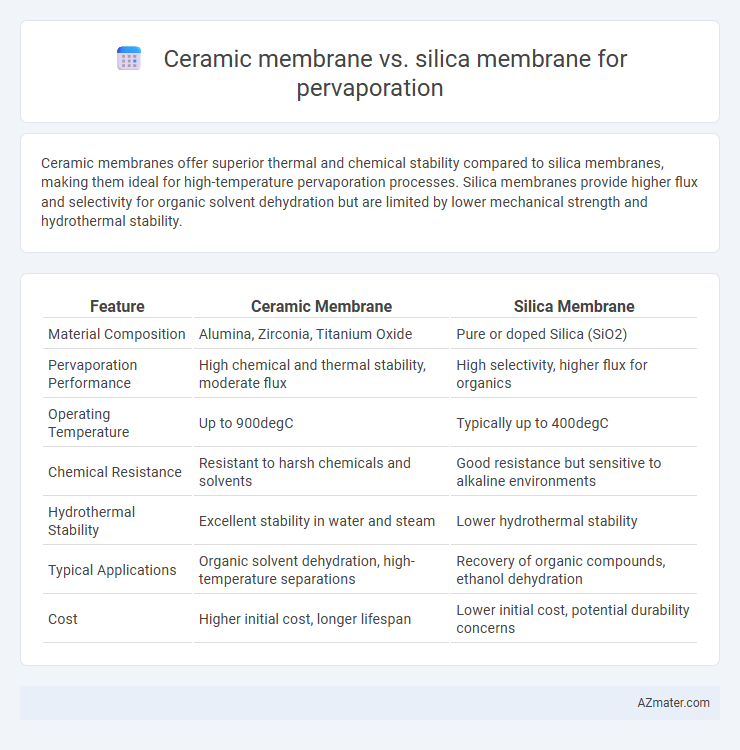Ceramic membranes offer superior thermal and chemical stability compared to silica membranes, making them ideal for high-temperature pervaporation processes. Silica membranes provide higher flux and selectivity for organic solvent dehydration but are limited by lower mechanical strength and hydrothermal stability.
Table of Comparison
| Feature | Ceramic Membrane | Silica Membrane |
|---|---|---|
| Material Composition | Alumina, Zirconia, Titanium Oxide | Pure or doped Silica (SiO2) |
| Pervaporation Performance | High chemical and thermal stability, moderate flux | High selectivity, higher flux for organics |
| Operating Temperature | Up to 900degC | Typically up to 400degC |
| Chemical Resistance | Resistant to harsh chemicals and solvents | Good resistance but sensitive to alkaline environments |
| Hydrothermal Stability | Excellent stability in water and steam | Lower hydrothermal stability |
| Typical Applications | Organic solvent dehydration, high-temperature separations | Recovery of organic compounds, ethanol dehydration |
| Cost | Higher initial cost, longer lifespan | Lower initial cost, potential durability concerns |
Introduction to Membrane Technology in Pervaporation
Ceramic membranes offer high thermal and chemical stability, making them suitable for harsh pervaporation conditions involving aggressive solvents and high temperatures. Silica membranes provide excellent selectivity and permeability for separating organic compounds, particularly in dehydration and organic-organic separation applications. Both membrane types enhance pervaporation efficiency by exploiting differences in molecular size and affinity, critical for advanced separation processes in chemical and environmental industries.
Overview of Ceramic Membranes
Ceramic membranes for pervaporation offer high thermal and chemical stability, making them suitable for harsh operating conditions compared to silica membranes. Their robust microstructure provides enhanced mechanical strength and longer lifespan, ensuring consistent separation performance. These membranes typically exhibit superior resistance to fouling and chemical degradation, critical for efficient volatile organic compound recovery and water removal applications.
Overview of Silica Membranes
Silica membranes for pervaporation exhibit high permeability and selectivity due to their unique microporous structure, making them ideal for separating organic compounds from aqueous mixtures. Compared to ceramic membranes, silica membranes offer superior chemical stability and hydrophobicity, enhancing their efficiency in dehydration and solvent recovery applications. Their tunable pore size and excellent thermal resistance contribute to prolonged membrane lifespan and consistent performance under harsh operating conditions.
Material Properties: Ceramic vs Silica Membranes
Ceramic membranes exhibit high mechanical strength, thermal stability up to 1000degC, and chemical resistance, making them ideal for harsh pervaporation conditions, while silica membranes provide excellent molecular sieving with pore sizes typically around 0.3-0.5 nm, promoting selective separation of small organic molecules and water. The inherent robustness of ceramic membranes ensures durability in aggressive environments, whereas silica membranes offer superior permeability due to their amorphous structure and hydrophilic surface properties. Material porosity and surface chemistry in ceramic membranes contribute to stability, while silica membranes rely on precise pore size distribution to achieve high selectivity and flux in pervaporation applications.
Pervaporation Performance Comparison
Ceramic membranes exhibit superior chemical and thermal stability, enabling higher flux and selectivity in pervaporation of aggressive organic mixtures compared to silica membranes. Silica membranes typically offer higher permeation rates for small molecules like water but suffer from hydrothermal instability, which limits long-term performance. In pervaporation separation of azeotropic mixtures, ceramic membranes provide more consistent separation factors and durability, enhancing operational efficiency and membrane lifespan.
Chemical and Thermal Stability
Ceramic membranes exhibit superior chemical and thermal stability compared to silica membranes, making them ideal for harsh operating environments in pervaporation processes. While silica membranes offer high selectivity, their lower thermal resistance limits their use to moderate temperatures and less aggressive chemical conditions. Ceramic membranes maintain structural integrity and performance at temperatures above 400degC and under highly acidic or alkaline conditions, ensuring long-term durability and efficiency in industrial applications.
Selectivity and Permeability
Ceramic membranes exhibit high chemical and thermal stability with moderate permeability, making them suitable for aggressive feed streams in pervaporation processes. Silica membranes offer superior selectivity due to their molecular sieving properties, achieving higher separation factors for organic compounds but often at lower permeability rates. Optimizing the trade-off between selectivity and permeability is critical for effective pervaporation system design, where ceramic membranes support durability and silica membranes enhance precise molecular separation.
Mechanical Strength and Durability
Ceramic membranes exhibit superior mechanical strength and durability compared to silica membranes, making them ideal for harsh pervaporation conditions involving high temperatures and aggressive solvents. Silica membranes, while providing excellent selectivity and permeability, tend to have lower resistance to mechanical stress and are more prone to structural degradation over time. The inherent robustness of ceramic membranes ensures longer operational lifespan and reduced maintenance costs in industrial pervaporation applications.
Cost and Scalability Considerations
Ceramic membranes offer higher durability and chemical resistance but come with a significantly higher initial cost compared to silica membranes, making them less attractive for large-scale industrial applications with tight budgets. Silica membranes, while generally less robust in harsh environments, provide lower material and fabrication expenses, enabling easier scalability and cost-effective deployment in commercial pervaporation processes. The trade-off between ceramic's longevity and silica's economical scalability drives material selection based on specific operating conditions and financial constraints.
Applications and Future Trends in Pervaporation
Ceramic membranes exhibit high chemical and thermal stability, making them ideal for harsh industrial pervaporation applications such as organic solvent dehydration and biofuel purification. Silica membranes offer superior selectivity and permeability, suited for the separation of water-organic mixtures and solvent recovery in pharmaceutical and petrochemical processes. Future trends emphasize the development of hybrid ceramic-silica membranes to enhance flux and selectivity, alongside integration with renewable energy sources for sustainable pervaporation systems.

Infographic: Ceramic membrane vs Silica membrane for Pervaporation
 azmater.com
azmater.com